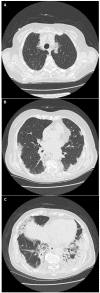Platypnea-orthodeoxia syndrome in SARS-CoV-2 related ARDS: a case report
- PMID: 35671104
- PMCID: PMC10510975
- DOI: 10.23750/abm.v93iS1.12824
Platypnea-orthodeoxia syndrome in SARS-CoV-2 related ARDS: a case report
Abstract
Platypnea-Orthodeoxia Syndrome (POS) is an often misdiagnosed clinical condition characterized by dyspnea and hypoxia in sitting or semi-sitting position, reversible in supine position. Although POS is typically associated with intracardiac shunts, it seems frequent also in SARS-CoV-2 related Acute Respiratory Distress Syndrome (ARDS). In fact, the prevalent involvement of the lung bases due to interstitial pneumonia can determine refractory positional hypoxemia, with marked desaturation in the sitting position and regression or improvement in the supine position, configuring the clinical picture of the POS. We present a clinical case of POS associated with acute respiratory distress from SARS-CoV-2 pneumonia in which refractory hypoxia would have required support by invasive mechanical ventilation if the syndrome had not been identified.
Conflict of interest statement
Each author declares that he or she has no commercial associations (e.g. consultancies, stock ownership, equity interest, patent/licensing arrangement etc.) that might pose a conflict of interest in connection with the submitted article.
Figures
Similar articles
-
Patent foramen ovale revealed by COVID-19 pneumonia.BMC Pulm Med. 2021 Apr 19;21(1):126. doi: 10.1186/s12890-021-01494-7. BMC Pulm Med. 2021. PMID: 33874930 Free PMC article.
-
Platypnea-Orthodeoxia and Patent Foramen Ovale in a Patient in the Setting of COVID-19.Tex Heart Inst J. 2025 May 28;52(1):e248401. doi: 10.14503/THIJ-24-8401. eCollection 2025 Jan-Jun. Tex Heart Inst J. 2025. PMID: 40443791 Free PMC article.
-
Platypnea-Orthodeoxia Syndrome after SARS-CoV-2 interstitial pneumonia: an overview and an update on our patient.Acta Biomed. 2022 Mar 14;93(1):e2022015. doi: 10.23750/abm.v93i1.11814. Acta Biomed. 2022. PMID: 35315410 Free PMC article. Review.
-
Platypnea-orthodeoxia after fibrotic evolution of SARS-CoV-2 interstitial pneumonia. A case report.Acta Biomed. 2020 Aug 10;91(3):ahead of print. doi: 10.23750/abm.v91i3.10386. Acta Biomed. 2020. PMID: 32921749 Free PMC article.
-
The multiple dimensions of Platypnea-Orthodeoxia syndrome: A review.Respir Med. 2017 Aug;129:31-38. doi: 10.1016/j.rmed.2017.05.016. Epub 2017 May 31. Respir Med. 2017. PMID: 28732833 Review.
Cited by
-
Multiplex protein profiling of bronchial aspirates reveals disease-, mortality- and respiratory sequelae-associated signatures in critically ill patients with ARDS secondary to SARS-CoV-2 infection.Front Immunol. 2022 Jul 29;13:942443. doi: 10.3389/fimmu.2022.942443. eCollection 2022. Front Immunol. 2022. PMID: 35967328 Free PMC article.
-
Platypnea-Orthodeoxia Syndrome in Coronavirus Disease 2019 Pneumonia: A Case Report and Literature Review.Int Med Case Rep J. 2023 Mar 27;16:201-207. doi: 10.2147/IMCRJ.S402537. eCollection 2023. Int Med Case Rep J. 2023. PMID: 37007669 Free PMC article.
-
Platypnea-Orthodeoxia Syndrome and COVID-19 Successfully Treated With Percutaneous Patent Foramen Ovale Closure: A Report of Two Cases and Literature Review.Cureus. 2024 Mar 21;16(3):e56655. doi: 10.7759/cureus.56655. eCollection 2024 Mar. Cureus. 2024. PMID: 38646276 Free PMC article.
References
-
- Montenegro F, Unigarro L, Paredes G, et al. Acute respiratory distress syndrome (ARDS) caused by the novel coronavirus disease (COVID-19): a practical comprehensive literature review. Expert Rev Respir Med. 2021;15:183–195. - PubMed
-
- Agrawal A, Palkar A, Talwar A. The multiple dimensions of Platypnea-Orthodeoxia syndrome: A review. Respir Med. 2017;129:31–38. - PubMed
-
- Lugara M, Oliva G, Pafundi PC, et al. Clinical application of lung ultrasound score on COVID-19 setting: a regional experience in Southern Italy. Eur Rev Med Pharmacol Sci. 2021;25:3623–3631. - PubMed
-
- Chang YC, Yu CJ, Chang SC, et al. Pulmonary sequelae in convalescent patients after severe acute respiratory syndrome: evaluation with thin-section CT. Radiology. 2005;236:1067–75. - PubMed
Publication types
MeSH terms
LinkOut - more resources
Full Text Sources
Medical
Miscellaneous


